When Charlene Luo was looking for a condo to buy in 2021, she had two nonnegotiable requirements: one, enough space to host friends for dinner; and two, a gas stove with the capacity to install a powerful range hood.
Luo, a data scientist, cooks every day and hosts a supper club from time to time in her Brooklyn apartment. She prefers a gas stove because she cooks with a wok, the deep, sloping pan that is the best vessel for preparing Sichuan dishes.
“So my wok is pretty much used for everything,” she says. “I use it to stir-fry, to deep-fry. I use it to steam things, boil things, braise things.”
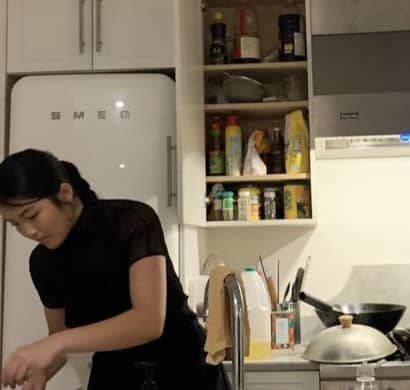
Charlene Luo at home.
Courtesy of Charlene Luo
The U.S. Consumer Product Safety Commission is reviewing gas stoves, citing studies about the health risks and effects on global warming caused by their emissions. “Any option is on the table. Products that can’t be made safe can be banned,” commissioner Richard Trumka Jr. said in an interview with Bloomberg.
California has already passed a law banning the installation of gas stoves in new construction, and New York City has a similar prohibition that will take effect in 2024.
For her part, Luo says she prefers a gas stove because the flames can reach up the sides of the wok and maintain contact with the wok even when she moves it around. Woks can also be flat-bottomed, but Luo’s has a round bottom, which is more traditional and conducts heat more evenly. On a flat-surfaced electric stove, she says, the wok would barely stand on its own and would not get hot enough.
Genevieve Yam, a culinary editor at the food website Serious Eats, also prefers a gas stove. Yam cooks a lot of Chinese dishes at home and relies on the flames of a gas stove to achieve the extremely high temperatures and precise control that cooking with a wok requires. And she doesn’t use her wok only for Chinese recipes.
A wok is for “anything that requires wok hei — when you want that really high heat to get a sear on something and when you want that slightly charred, smoky flavor,” Yam says.
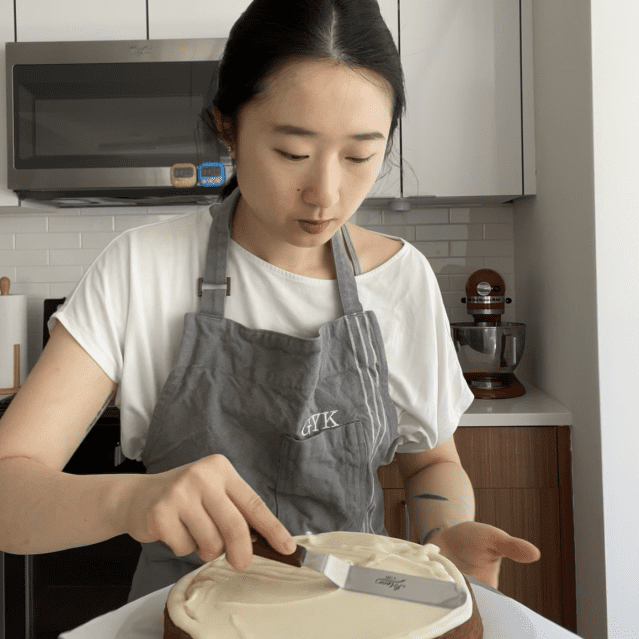
Genevieve Yam, a culinary editor at Serious Eats, has a background as a pastry chef. At home, she cooks with a wok on a gas stove.
Courtesy of Genevieve Yam
Wok hei means “breath of the wok.” The term, which culinary historian Grace Young helped introduce to an American audience, describes the characteristic flavor of Cantonese dishes in particular. But people seek this flavor in other dishes as well, including Chinese kung pao chicken, Thai pad see ew and the fried-rice dishes prepared in various Asian kitchens.
“If you’re making char kway teow, which is a kind of Singaporean noodle dish, you really want something like a wok to prepare it,” Yam says. “There are just some things that you can’t really replicate in a Dutch oven or a cast-iron skillet or a nonstick pan — simply just because those vessels don’t conduct heat in the same way.”
But after a consumer-safety official in early January floated the possibility of a federal ban on gas stoves, Yam started wondering how she would cook at home if her landlord were to replace the gas stove in her apartment with something else. Would she still be able to get the level of heat and control needed to cook with a wok?
Now home cooks like Yam and restaurants across the country are worrying about the fate of gas stoves, saying officials are failing to consider the financial costs of a ban as well as how it could affect people’s livelihoods and cultural traditions.
Why do people prefer gas stoves for cooking with woks?
Wok cooking is all about extreme precision and extremely high heat, says Ming-Jinn Tong, the founder of Hot Wok Academy, a cooking school in Minneapolis that focuses on Asian ingredients, tools and techniques.
“What’s very important in wok cooking is that you are able to control the temperature in two ways: number one, very precisely, and number two, very rapidly,” Tong says. “If I want high heat, I need high heat immediately, and if I need it to be cool, I need to cool it immediately.”
The average wok is only about one-third as thick as a standard pan, which means it doesn’t retain heat as well and therefore requires a more powerful heat source, according to J. Kenji López-Alt, author of the bestselling book “The Wok: Recipes and Techniques.”
“‘What’s very important in wok cooking is that you are able to control the temperature in two ways: number one, very precisely, and number two, very rapidly.’”
“Not only must the pan be ripping hot to start, but with most recipes you need to keep it above a high flame the entire time you cook in order to replenish the energy being pumped into the food,” López-Alt wrote in a Serious Eats article adapted from his cookbook.
Tong says that two physical movements help a cook achieve wok hei, that characteristic smoky flavor that is the result of the Maillard reaction, the caramelization of sugar and protein. One, he says, is tossing the food into the air to catch evaporated oil after the temperature reaches 425 degrees. The other involves bringing the flame into the wok itself.
“When the oil vapor is leaving the wok, what you can do is you can tip the wok toward the open flame and the open flame will ignite the oil vapors. And that oil vapor catching on fire adds yet another different flavor to the food,” he says. “Then it really creates that wok hei flavor. The smoky flavor of fried rice is from the open flame from gas or charcoal.”
But is a gas stove the only convenient way to achieve that flavor?
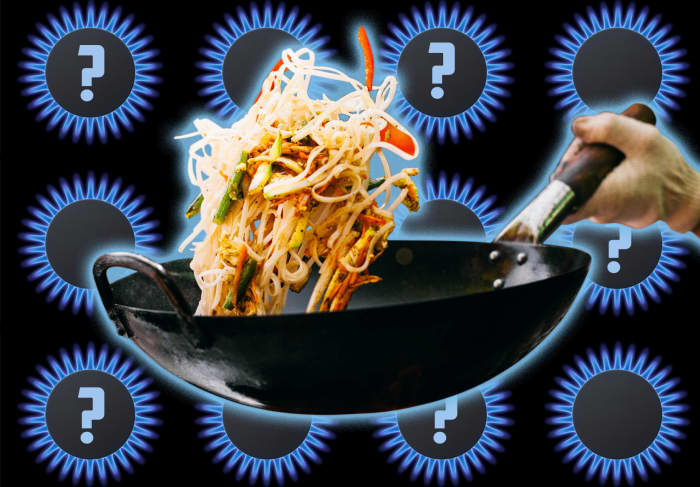
The U.S. Consumer Product Safety Commission is reviewing gas stoves, citing studies about the health risks and effects on global warming caused by their emissions.
MarketWatch photo illustration/iStockphoto
Are there alternative heat sources that work for wok cooking?
While gas stoves provide an easy and convenient way to replicate ancient methods of cooking on wood or charcoal, some Asian chefs have turned their attention to other heat sources, including induction burners, which use a magnetic current to move iron particles in the cookware, producing heat.
Nite Yun, a chef and the owner of a Cambodian restaurant in Oakland, Calif., called Nyum Bai, demonstrated how to cook lok lak, a black-pepper and beef dish, using an electric induction burner designed to hold a wok in a video from East Bay Community Energy, a community-led clean-energy provider. In the video, Yun said she was impressed with how the induction burner heated up within a few seconds after she set the temperature.
In 2019, the Museum of Food and Drink (MOFAD) in Brooklyn brought in guest chefs to prepare kung pao chicken, wontons and chow mein on an induction burner for its exhibition “Chow: Making the Chinese American Restaurant.”
The induction burner “got extremely hot,” the museum said in an email to MarketWatch, adding that this “surprised many guest chefs who cooked on it.”
Jon Kung, a professional chef based in Detroit, Mich., has been using an induction wok burner in videos he posts on social media. He says he’s impressed by its efficiency and how easy it is to clean, and also finds it more pleasant to use.
“There was less heat dissipation, so my crew was a lot more comfortable. I was a lot more comfortable,” he says.
Home cooks sacrifice very little by using induction heat, Kung says, because a household gas stovetop can’t achieve the power of a restaurant stove anyway. In addition, he noted in a tweet, the history of wok cooking far predates the history of gas stoves, which means adaptability is part of the wok’s history. The timing and techniques of induction cooking require some adjustments, he says, but it doesn’t take long to get used to it.
And because of how practical the induction burner is, Kung thinks it could appeal to older Asian people, because their main focus is practicality — feeding the family by cooking with a wok.
“My grandmother is not with me anymore, but I could hear [her] in my head [saying], ‘Lei tai!’ [Cantonese for ‘look here’]. ‘How easy — or how much easier this is to wipe down instead of getting in between the grates of the gas cooktop,’” Kung says. “I don’t think it is as hard a sell as one might think.”
As for bringing the open flame into the wok, Kung admits that he’s not sure how to replicate that with an induction burner. But he adds that it might not matter much, because even though Chinese cooking is known for being a bit flashy and dramatic, home cooks don’t often use that technique.
“We have a flair when it comes to our style, so it follows that we don’t want to see one of those primary romantic elements taken away,” he says. “But people were not getting that at home anyway.”
What’s at stake for restaurants?
Wok hei is a flavor people are more likely to find in restaurant dishes. A commercial gas stove reaches up to 200,000 British thermal units (BTUs), whereas household gas stoves go from 500 to 18,000 BTUs. There are other ways to replicate that taste at home, such as using a handheld torch or making smaller amounts of food at one time in the wok, but it’s never quite the same.
That’s why George Chen, the executive chef, founder and CEO of the fine-dining China Live Group in San Francisco, says a gas-stove ban would be detrimental to the cooking at his and other restaurants.
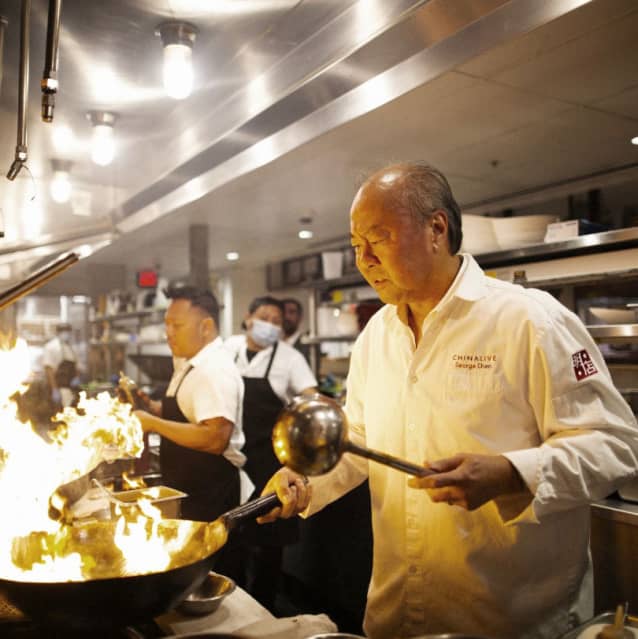
George Chen is the CEO, founder and executive chef of China Live Group in San Francisco.
Courtesy of George Chen
Although not all dishes need wok hei and the open flame that goes into the wok, Chen says, the fire is not just for show. “Nobody wants to burn their nose off for the show,” he says.
Rather, it serves a purpose in creating flavor — and that’s what brings people to his restaurants.
“When you’re doing kung pao chicken, you’re taking raw protein, vegetables, peppers, and you’re blasting it with high heat. The peppers will release a certain oil that flavors the chicken, and to get to that temperature and to be able to bring that xiang [Mandarin for ‘fragrance’], the umami, to bring that flavor into the wok, you have to be able to have that technique,” Chen says. “It’s not [just] the romance of it.”
“‘Nobody wants to burn their nose off for the show.’”
Chen is testing induction wok stations from different brands. But there are challenges, he says, with the first being cost. Swapping out existing gas-powered stations for commercial induction burners for woks could triple the cost of setting up a restaurant.
The induction wok burner that Kung uses in his videos costs around $ 200 and comes with a wok, but the products from the brand that MOFAD used in its exhibition are priced closer to $ 2,000. That cost is too high for most small-restaurant owners in particular, Kung says, and not just Asian ones.
There are technique challenges, as well. Although the necessary adjustments and timing changes might not matter as much to home cooks, they will affect the techniques Chen uses to achieve the flavor profiles he’s seeking for his restaurants. And if he has to change the heat source and techniques, he says, it might mean rethinking the whole menu.
Take tossing, for example. Once the wok leaves the burner surface, whether it’s electric-coil or induction, the heat is gone. “There’s no wok tossing with electric,” Chen says. “There’s no point. There’s no flame underneath. Once we elevate it off of the induction, there are no more heat transfers.”
He feels strongly about being compelled to make such a change. “I’m not against electrification of most of it. But I think to legislate it all out is doing great cultural damage,” Chen says. “It’s insulting. It’s sacrilege.”
Who could be hurt by a ban?
Yam, the Serious Eats editor, agrees that a gas-stove ban could force lifestyle changes for people. It’s a sensitive topic that adds to the history of neglect the Asian American community feels — especially when there might be bigger sources of harmful emissions at home.
“Maybe you should start with changing your [furnace] to electricity instead of gas before you infringe on what feels like such a fundamental way of life for a lot of people,” she says. “It’s one of those things where you can’t even have one thing. It’s like, it’s a gas stove to prepare the food of your culture and you can’t have it.”
At the moment, the Inflation Reduction Act allows homeowners to take advantage of up to $ 14,000 in rebates and tax credits for making energy-efficient upgrades — including, in some cases, switching out gas appliances for electric ones. How much a homeowner can get back will depend on how much they earn, where they live and what improvements they make.
But as a renter, Yam wonders whether her landlord would be willing to cover the expense.
“Most people are just trying to get their landlord to fix the heat or to fix a broken window, you know,” she says. “The last thing on their mind is probably whether their landlord is going to go induction or gas.”
Everyday wok cooking is not about wok hei
Although Luo prioritized a gas stove when she was hunting for a condo, she actually learned to cook on an electric stove. Her parents still use one, pairing it with a powerful range hood at their Minnesota home.
But even when she cooks with a gas stove, Luo says, she’s not aiming for wok hei.
“I’m not getting any wok hei at home. I’ve completely come to terms with that. It’s not going to happen,” Luo says.
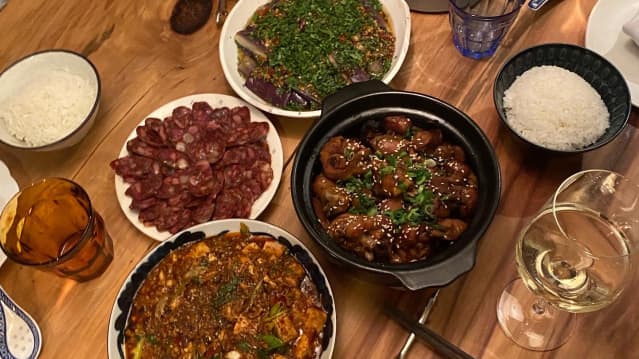
Charlene Luo frequently hosts dinners for friends, and sometimes for the public, and she does most of the cooking in a wok.
Courtesy of Charlene Luo
She says using gas stoves for her wok cooking was a personal preference. “It’s more just like, the wok is nice because it doesn’t splatter. It’s like a high wall. I can stir-fry easily,” she says. “For me, it’s a comfort thing and it’s a habit — being able to see the flame, being able to move my wok. ”
But gas stoves are not the only way, says Tane Chan, the owner of the Wok Shop in San Francisco’s Chinatown, a mecca for Asian cooks for the past 57 years. “I raised my kids with cooking on an electric stove,” Chan says.
The core of wok cooking, as she sees it, is its affordability and versatility. People adapt and cooks adapt, she says. There are also different woks designed for different stovetops.
“Woks are for all walks of life,” Chan says. “Don’t blame the wok. Don’t blame anybody else. Blame the cook. If he’s a good cook, he’ll even make a very delicious dish in the skillet.”
